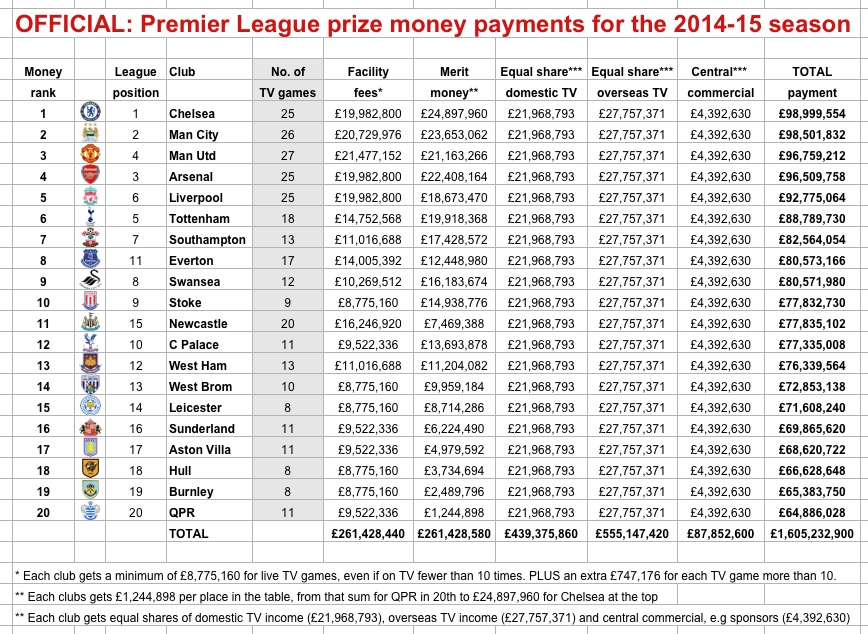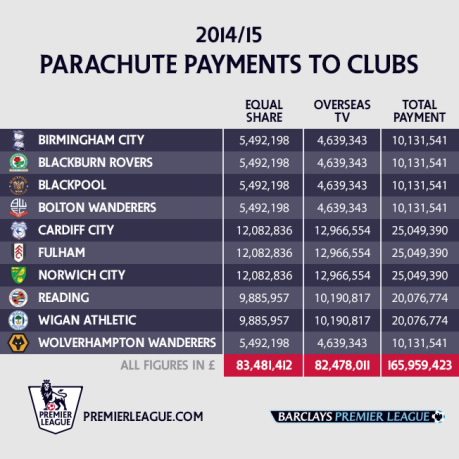By Sportingintelligence
2 June 2015
Chelsea’s Premier League title success has also lifted them to the top of the prize money table for 2014-15, with official figures released today showing they will pocket £98,999,554 from central funds alone.
The money comes primarily from the PL’s huge TV deals but also includes Chelsea’s share of the league’s central commercial income.
Manchester City were the second highest earners from PL funds behind Chelsea, making £98.5m, followed by Manchester United, Arsenal and Liverpool. The lowest earning club, QPR, earned £64.9m, the biggest sum ever for a bottom-placed club.
Article continues below
Chelsea’s money was made up of £24.9m ‘merit’ cash for finishing top of the table, £19.98m ‘facility fees’ for being in so many live TV games, plus equal shares of the domestic TV deal (nearly £22m), overseas TV deals (£27.8m) and commercial income from the leagues sponsors, such as Barclays (£4.4m).
Sky and BT Sport are paying £3.018 billion between them to show Premier League matches live in the UK across three seasons from 2013 to 2016 inclusive. Foreign broadcasters around world are paying another £2.23 billion combined, on top, for the same period.
The Premier League also earns money from the sales of highlights (on Match of the Day), near-live rights, clip rights, and brings in further sums from commercial deals like the one with headline sponsor Barclays. All that cash goes into one big pot and the sums announced today are the eye-watering rewards for the clubs.
They will get bigger in future. The domestic deals will rise from £3.018bn to £5.136bn in the three-year period from 2016-17, and the foreign deals are expected to climb from £2.23bn to around £3bn.
This year every club gets an ‘equal’ share of around £54m derived from domestic TV income, overseas income and commercial income, with specifics in the graphic above.
Every club then gets another sum depending on league position, worth £1,244,898 per place in the table, from that sum for bottom-placed QPR to £24,897,960 to winners Chelsea.
Payments for 2013-14 / Payments for 2012-13 / Payments for 2011-12 / Payments for 2010-11 / Payments for 2009-10
Each club also gets a variable amount depending on how many times they were shown live on Sky or BT this season. Every club got a minimum of £8,775,160 from this pot, even if they were shown as rarely as Hull, Burnley and Leicester (just eight live televised games each). United were shown most, 27 times.
Clubs have three main revenue streams: match day income (from tickets, corporate dining etcetera), media income (of which the payments listed are the largest but not the only part) and commercial income (from kit deals, sponsorship, merchandise, tours and so on).
RELATED STORY: It’s the economy, stupid! How money fuels glory in the Premier League
The ratio in central earnings between Chelsea at the top and QPR at the bottom in 2014-15 is 1.53 to one. This is a much lower ratio – and therefore ‘fairer’ split of TV money – than occurs in Europe’s other major leagues.
In Spain’s top division, where Barcelona and Real Madrid take the lion’s share of the TV cash because they do their own deals and don’t sell rights collectively, the equivalent ratio is around 11.3 to 1.
In Italy’s Serie A, the ratio is about 4 to 1, in France’s Ligue 1 it is about 3.7 to 1, and in the German Bundesliga it is 2 to 1. In the Champions League, the equivalent ratio between the winner and the team finishing ‘bottom’ (ie a final-stage qualifier before the group) is 30 to 1.
Parachute payments
The Premier League have also announced a new distribution mechanism for parachute payments, to be handed out over three years from 2016-17, not four as now, and only for two years for clubs staying just one season in the Premier League.
A complex formula is currently used to calculate parachute money, paid to clubs in their first few years after relegation from the top division. Cardiff, Fulham and Norwich received £25m each for the 2014-15 season after demotion last summer, for example, while Reading and Wigan, who went down the year before, got £20m. See table for details. Article continues below
From 2016-17, clubs in their first year down will receive 55 per cent of an equal share of domestic money plus an equal share of overseas money. That is likely to be a payment of around £40m by then. The second year payment will be 45 per cent, and the third year payment 20 per cent.
This reduction in parachute money – in terms of years – is balanced by more money going each season to all lower division clubs.
From 2016-17 onwards, all Football League clubs will receive solidarity payments from the Premier League which amount to a percentage of the value of a Year 3 parachute payment; 30 per cent for clubs in the Championship, 4.5 per cent for clubs in League One and 3 per cent for clubs in League Two. The upshot will be they receive more than currently.
.








